Hi, kids!
This section is a place where you can learn about our company, Minato Mirai 21 District Heating and Cooling Co., Ltd. (we’ll call it “MM21 DHC” for short) and the work we do, which is district heating and cooling (“DHC”).
We hope you’ll study these things to help protect the rich, green, natural beauty of Earth, including the oceans and countryside we all like to visit and play in.
About Minato Mirai 21
Children in Japan learn in history class that during the Edo period, which lasted from 1603 to 1868, Japan shut itself off from the rest of the world. The door to foreign countries was shut everywhere, except for Nagasaki, in Kyushu. When the Edo period ended, four more doors opened to the wider world. One of those was Yokohama (the others were Hakodate, Niigata and Kobe). In 2009, Yokohama celebrated the 150th anniversary of that opening.
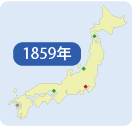
In those days Japan was well behind Western countries in scientific knowledge. When the port of Yokohama was opened to the world, a lot of new scientific knowledge came into Japan through that port.
Yokohama was a city that had opened the door to new scientific knowledge—in other words, to the future.
This open port put Yokohama a step ahead of the rest of Japan. To make Yokohama a city that would always think about the future, we created Minato Mirai 21. Minato means “port,” Mirai means “future,” and “21” refers to the 21st century.
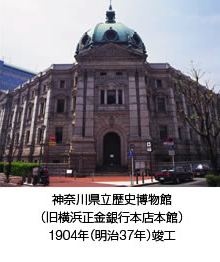
Minato Mirai 21 and MM21 DHC
Yokohama is home to many high-rise buildings, like Yokohama Landmark Tower or Queen’s Square Yokohama, where you can enjoy eating and shopping, go to a concert or stay with your family at a hotel. You may have already visited some of these places. Other high-rise buildings have offices where people work, apartments where people live, as well as theaters and art galleries and more. There are lots of buildings here, where lots of people go about their daily lives.
Our job at MM21 DHC is to heat and cool these buildings. We keep people cool in the summer and warm in the winter. At our factories, we have huge air conditioners and heaters that we use to heat and cool an entire city district. That’s what we call “district heating and cooling.”
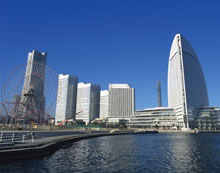
What is District Heating and Cooling?
In places where lots of buildings are close together, district heating and cooling is a good way of heating and cooling them. We use huge machines to produce the heating and cooling buildings need, then deliver that heating and cooling to each building through tunnels built underground. But why not just let each building handle its own heating and cooling? There are many good reasons.
One reason is that the buildings are big, so they need big machines to heat and cool them. If each building had its own heating and cooling machines, they would need machines and chimneys on the roof. But with district heating and cooling, the energy for heating and cooling is made in the factory and sent to each building through tunnels, so the buildings don’t need their own machines. That means there’s more space in the buildings for the people to use. Also, there are no chimneys, so gardens and parks can be put on the rooftops.
District heating and cooling is good for the earth
Energy is valuable and the hot or cold air used for district heating and cooling is all made in one place so the energy needed to make it can be used without wasting any. And there’s no dirty air containing nitrogen oxide and sulfur oxide from chimneys, so district heating and cooling is better for the earth.
You’ve probably heard about global warming. The carbon dioxide created by many of the things people do is making the earth warmer, and this is a big problem. But district heating and cooling doesn’t make much carbon dioxide, so it helps to prevent global warming. In science class, you may have learnt about photosynthesis already. Using photosynthesis, green plants change carbon dioxide into oxygen. In reducing carbon dioxide, the work that Minato Mirai 21 Heating and Cooling does has the same effect as a forest 570 times the size of a major arena like Yokohama Stadium, or approx. 3,700 acres.
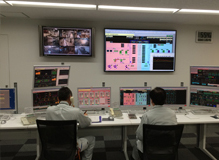
Chillers for Cooling
The cool air created by air conditioning comes from cold water produced by many huge air-conditioning machines, called chillers, inside the plant. The cold water passes through underground tunnels to the buildings, where it cools the air that is blown into each building’s rooms to cool them. The chillers MM21 DHC uses in its factories, called electric centrifugal chillers, are the biggest machines of their kind in the world. Each one is so big that it would take 5,400 air conditioners of the type most Japanese people have in their homes (for a 12-mat room) to generate the same amount of cool air.
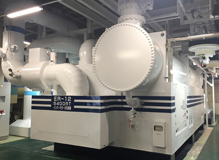
Boilers for Heating
The cool air created by heating comes from hot steam (170°C) produced by many huge water-heating machines, called boilers, inside the plant. Just like the cold water from the chillers, this steam passes through underground tunnels to the buildings. There it heats the air that is blown into each building’s rooms to heat them. The biggest boilers MM21 DHC uses in its factories are big enough to heat 5,000 Japanese homes, the same as 10,000 space heaters.
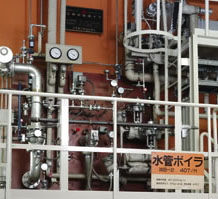
Let’s Think About the Earth Together
At MM21 DHC, our job is district heating and cooling. We hope you’ll understand how important district heating and cooling is for protecting this beautiful Earth we live on.
And you can do your part to protect the Earth. Be sure not to waste electricity when you’re at home. If there’s nobody in a room, turn the lights off, and don’t leave the TV on when you’re not watching. Keep the refrigerator door closed. When we burn oil and gas, or waste electricity, we make carbon dioxide, which is a factor in global warming.
Luckily, trees and other plants absorb carbon dioxide! So let’s all take good care of our green spaces. Let’s all think and study for ourselves about this Earth we live on.






